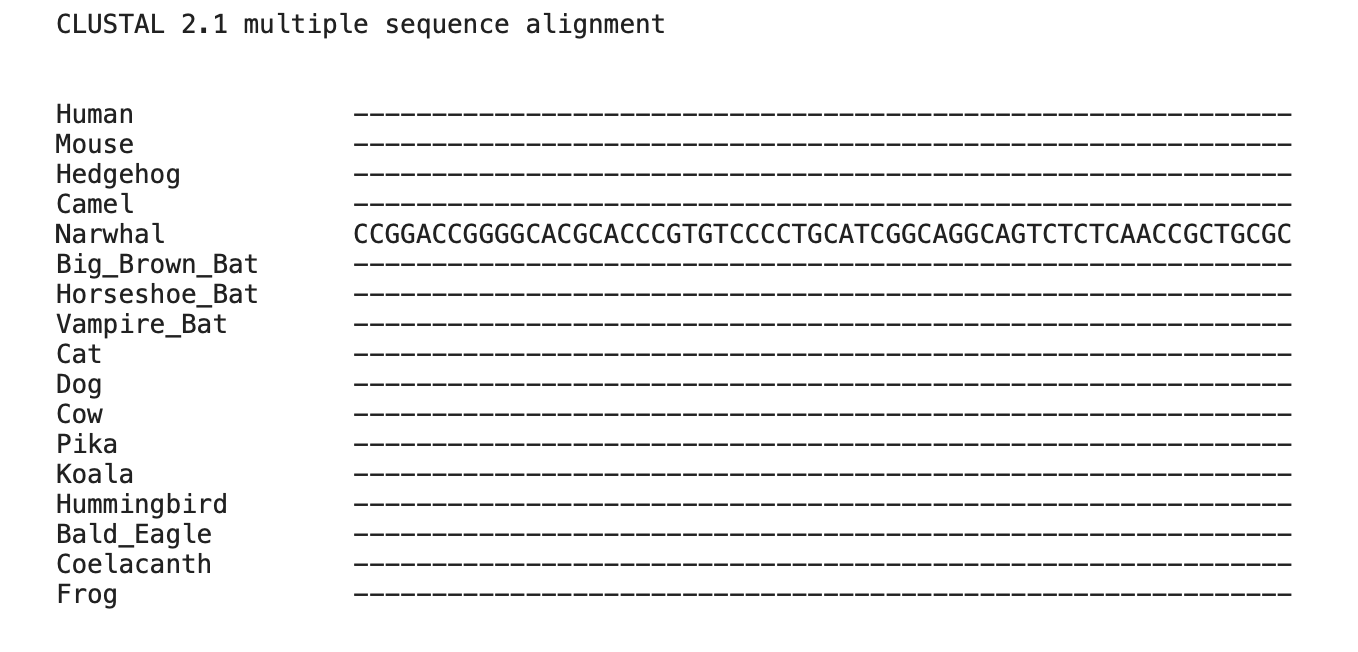Tree of Life Activity Part 3
Compute and Visualize a Phylogenetic Tree
COVID-19 is caused by a type of coronavirus, SARS-CoV-2, and can infect a variety of animal species, including cats, dogs, lions, and tigers. The coronavirus gets inside the cells of animal hosts and causes infection by binding to a specific gene, called ACE2.
ACE2 is an important gene in animals because it is involved in homeostasis. ACE2 is especially interesting to scientists right now because of its assocation with the coronavirus.
Scientists can use a phylogenetic tree to understand how the DNA sequence of ACE2 is similar or different among many different animals, and to identify animals that could potentially be infected by the coronavirus.
In today's activity, we will use the sequence of the ACE2 gene from different animal species to construct a phylogenetic tree and compare how related they are.
Once we create our tree, we will be able to make inferences about which species are more closely related to each other, based on our visual analysis!
We will use DNA sequences for the following animals:
Common Name Scientific Name
Human Homo sapiens
Mouse Mus musculus
Dog Canis lupus
Cow Bos taurus
Cat Felis catus
Frog Xenopus tropicalis
Pika Ochotona princeps
Coelacanth Latimeria chalumnae
Hedgehog Erinaceus europaeus
Big Brown Bat Eptesicus fuscus
Hummingbird Calypte anna
Bald Eagle Haliaeetus leucocephalus
Camel Camelus dromedarius
Koala Phascolarctos cinereus
Vampire Bat Desmodus rotundus
Narwhal Monodon monoceros
Horseshoe Bat Rhinolophus ferrumequinum
Compute and visualize a phylogenetic tree
You will need to navigate to your Jupyter notebook to complete this activity
In this activity we will use a Jupyter Notebook that has some pre-written code. Here is a button to open Jupyter if you don't already have it open:
Access the notebook for this activity by typing the following command in your Jupyter notebook environment:
import os
os.system("wget http://compbiocamp.cgrb.oregonstate.edu/notebooks/Activity3_TreeOfLife_Part3.ipynb")

After we align our sequences with clustalw2, we will want to look at the file containing the multiple sequence alignment, called "ACE2.aln"
To do this, you will need to navigate to a "Bash" kernel from your Jupyter notebook page

Once we have an open terminal window, we will type the command below and press "play":
less ACE2.aln
The contents of the file should look like this:

The alignments in this file let us see where gene sequences are very similar
The '*' character in the last row indicates a perfect alignment: all species share that particular nucleotide
Human TTTGCTTGGTGATATGTGGGGTAGATTTTGGACAAATCTGTACTCTTTGACAGTTCCCTT
Mouse TTTGCTTGGTGATATGTGGGGTAGATTTTGGACAAATCTGTACCCTTTGACTGTTCCCTT
Hedgehog TTTGCTTGGTGATATGTGGGGTAGATTTTGGACAAATCTATACCGCTTGACAGTCCCCTA
Camel TTTGCTTGGCGATATGTGGGGTAGATTTTGGACAAATCTATACTCTTTGACAGTCCCCTT
Narwhal TTTGCTTGGTGATATGTGGGGGAGATTTTGGACAAATCTGTACCCTTTGACAGTCCCCTT
Big_Brown_Bat TTTGCTTGGTGATATGTGGGGTAGATTTTGGACAAATCTGTACAATCTGACAGTCCCCTT
Horseshoe_Bat TTTGCTTGGTGATATGTGGGGTAGATTTTGGACAAATCTGTACCCTTTGACAGTCCCCTT
Vampire_Bat TTTGCTCGGTGATATGTGGGGTAGATTTTGGACAAATCTGTACAATTTGACAGCCCCCTT
Cat TTTGCTTGGCGATATGTGGGGTCGATTTTGGACAAATCTGTACCCTTTGACAGTCCCCTT
Dog TTTGCTTGGTGATATGTGGGGTAGATTTTGGACAAATCTGTACCCTTTGACAGTCCCCTT
Cow TTTGCTTGGTGATATGTGGGGGAGATTTTGGACAAATCTGTACTCTTTGACAGTCCCCTT
Pika TTTGCTTGGTGACATGTGGGGTAGATTTTGGACAAACCTGTACTCTTTGACAGTCCCCTT
Koala TTTGCTTGGTGATATGTGGGGCAGATTTTGGACAAATCTATATTCACTGACAGTGCCCTA
Hummingbird CTTGCTGGGTGATATGTGGGGTAGATTTTGGACAAATCTGTATCCCTTGACTGTTCCCTA
Bald_Eagle CTTGCTGGGTGATATGTGGGGTAGATTTTGGACAAATCTGTATGCCTTGACCGTTCCCTA
Coelacanth TTTACTTGGTGACATGTGGGGAAGATTTTGGACAAACTTGTACCCCTTGGCTGTCCCATA
Frog TTTGCTTGGTGATATGTGGGGAAGATTTTGGACAAATTTGTATCCTCTGATGGTCCCCTA
** ** ** ** ******** ************* * ** ** * ** *
We can also see where parts of the sequence are similar only among certain species
The '-' character indicates where a matching sequence is missing from the alignment
Question: in the section of the alignment shown below, which species are most similar? Most different?
Human AA---TCTATGTTTTTCCTCTTGAGGTGATTTTGTTGTATGTAAATGTTAATTTCAT--G Mouse AG---CACTTGTC---------------ATCTTCCTGTATGTAAATGCTAACTTCAT--A Hedgehog AAG-CCGTTTGCATTTCTCCTTGAGGTGATTTGATTATCCATAAATATTAATTTCA---- Camel AA--TCTATTTTATTTCCTCTTGAGGTGATTTTATTGTATGTAAATGTTAGTTTCAC--G Narwhal AA--TCTCTTTTATTTCCTCTTGAGGTGATCTTATTGTATGTAAATGTTAATTTCAC--A Big_Brown_Bat AA--TCCATTTTATTTCCTCTTGAGGTGATTTTATGGCATGTAAATGTTAATTTCAC--A Horseshoe_Bat AA--TCTATTTTATTTCCTCTTGAGGTGATTTCATTGTATGTAAATGTTAATTTCGT--A Vampire_Bat CA--TCATTTATATTTTCCCTTGAGGTGATTTTATCATACATACATGTTAATTTCAC--A Cat AA-------TCTATTTCCTCTTGAGGTGATTTCATTGTATGTAAATGTTGATTTTAC--G Dog ------------------------------------------------------------ Cow TAG-TCATGAGAAGC------TAAAATAGGACTCGTGTACTTCTGTGTCAAG---AT--A Pika AGT-CCTTTTCTTTTTGAGGTGAAGTTAATGTGGCAGGCCGAAAGAAGCGAGAACA---A Koala AT----CTTTTCATTT----TTTTACTCATTTCATTTCCTGTCAATACTAACATTATGTA Hummingbird ATG-AATCTACA------------------------------------------------ Bald_Eagle ------------------------------------------------------------ Coelacanth AAA-ATAAATATGAAAAAGTCTCAATTAATTCCCTTTTAATTGTGCTCTTAAA------- Frog AGCATTTGATGGAAATGATAATAAAGCGATTGACGGAAATGACAATAAAGGGATTGA-TG
Back to Main Activity Page Previous Activity Next Activity